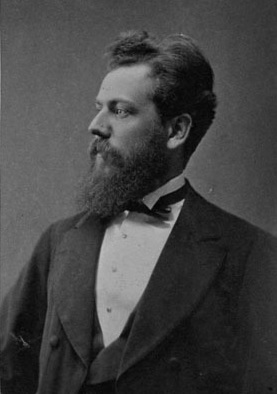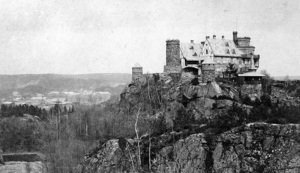Ture Malmgren facts for kids
Quick facts for kids
Ture Malmgren
|
|
|---|---|

Ture Malmgren
|
|
| Born |
Ture Robert Ferdinand Malmgren
7 June 1851 |
| Died | 3 August 1922 (aged 71) |
| Occupation | Journalist, publisher, politician |
Ture Robert Ferdinand Malmgren (born June 7, 1851 – died August 3, 1922) was a Swedish journalist, book publisher, and local politician. He was a very important person in his hometown of Uddevalla. Malmgren became famous in the city's history because he owned the newspaper Bohusläningen for a long time. He also worked in local politics, lived a very unique and grand life, and built a special castle called Tureborg Castle that looked like it was from the Middle Ages.
Contents
Ture Malmgren's Story
Growing Up and Early Adventures
Ture Malmgren was born in Uddevalla in 1851, when Sweden and Norway were united. His father, Carl Gabriel Malmgren, was a book publisher and owned Bohus Läns Tidning, Uddevalla's first newspaper. Ture grew up around printing presses and books. He became interested in journalism early on. In school, he didn't do well in most subjects, but he got the highest grade for "effort"!
When he was young, Ture traveled a lot to other countries. He visited places like Italy and Germany. His boat trips on the Rhine River in Germany later gave him ideas for his castle. He also traveled to Australia and the Pacific Islands. These trips inspired him greatly.
In 1878, when Ture was 27, he started his own publishing company. By August of that year, his company was set up in a building in Uddevalla. In September, he got permission to publish his own newspaper, Bohusläningen. It covered news from Uddevalla and the surrounding areas. The first "test" issue came out on October 21 and was given out for free. The newspaper officially started printing on November 4.
Building a Newspaper Empire
For a short time, Ture's own father was his main competitor in the newspaper business. But soon, Ture's newspaper, Bohusläningen, became very successful. It was especially popular among people who believed in liberal and progressive ideas. Ture wrote a story called Under södra hemisferens himmel (meaning "Under the sky of the southern hemisphere"). It was a romantic story about his adventures in the Pacific Islands and Australia, where he said he had searched for gold.
On March 13, 1882, Ture married Hilma Olsson. Ture was very good at business and beat all his newspaper rivals. When Bohus Läns Tidning closed down in 1884, he bought what was left of it and combined it with Bohusläningen. He also bought out all the other owners, becoming the newspaper's only owner. He kept expanding, and by 1885, the newspaper was printed every other day. Other newspapers tried to compete, but none of them lasted long against Ture's successful Bohusläningen.
Grand Projects and Unique Homes
As his newspaper grew, Ture Malmgren became very wealthy. He started several amazing building projects. First, he built Villa Elfkullen in 1887. It was located outside the city and was meant to be a summer home. It was decorated in a very grand way. After an expansion in 1901–1902, it had beautiful interiors designed by the artist Vicke Andrén. The villa also had a "Chinese tower" that looked like a Chinese pagoda, a working drawbridge, and many secret rooms!
In 1899, he began building the magnificent Tureborg Castle, named after himself. This castle, which looked like an old fortress, was inspired by his trips to Germany. It was built on a hill overlooking Villa Elfkullen and was finished in 1912. The castle had almost forty different rooms, a large hall with stone pillars, several towers, balconies, and tall stone walls. Just like his villa, it had a secret passage that opened by pressing a hidden button! Ture built the castle without proper blueprints, using postcards of the Rhine Valley as his guide. He often held big parties at the castle, inspired by old Swedish traditions. They would have roasted pigs and mead (a drink) served in wooden cups. Ture was very afraid of snakes. He paid people to clear the castle area of snakes, giving them money for every dead reptile they brought him.
Political Life and Beliefs
Ture Malmgren was involved in politics from the start. He cared a lot about his local area and region. In 1890, he became the first leader of the Uddevalla Suffrage Association. This group was an early part of the Swedish labour movement in the city. Even decades before women could vote in Sweden, Malmgren strongly supported women's suffrage (the right for women to vote) and universal suffrage (the right for everyone to vote).
He also supported other important ideas:
- Better social care for people.
- More compulsory education (making school required).
- Shorter working time for workers.
- State pensions for workers (money for people after they retire).
He believed workers had the right to strike to get fair treatment. Malmgren was also a strong republican and did not support the monarchy (the king and queen). He caused a small stir when King Gustaf V visited Uddevalla in 1915. Ture first refused to go to the King's event. When he was convinced to go, he left early before the King did! After slowly stepping back from his newspaper, he spent several years as the Chairman of the Uddevalla City Assembly.
Malmgren was also active in many non-profit groups. These included theater groups and associations that planted trees. He was also part of the large temperance movement, which worked against alcohol. However, after he failed to become the leader of the movement in Uddevalla, he became a fan of wine instead.
Later Years and Legacy
Ture Malmgren passed away on August 3, 1922, at the age of 71. He died from a heart attack after being sick with diabetes for a long time. For the last six years of his life, he couldn't visit his castle, only admiring it from afar. Ture and his wife Hilma did not have children. He left all his money to Hilma.
Ture wanted to be buried in a cave behind his home, but the city decided to bury him in the Eastern Cemetery. Hilma never went back to Tureborg Castle after his death. She lived the rest of her life in Villa Elfkullen and was buried next to Ture when she died in 1942. Their grave has a large tombstone with a carved picture of Ture.
After Ture's death, Tureborg Castle was rented out and slowly started to fall apart. Villa Elfkullen also became old and worn after Hilma died. In 1950, the castle burned down, leaving only a ruined shell. Today, the ruins of Tureborg are one of Uddevalla's most famous landmarks. Villa Elfkullen, however, was fixed up in 1980 and saved from being torn down. A group called Föreningen Villa Elfkullen (the Villa Elfkullen Association) takes care of it. They have about 400 members, and thousands of people visit the villa every year. The building was given special protection in 2001 and displays many of Ture Malmgren's personal items.
The neighborhood near Villa Elfkullen and Tureborg Castle is now named Tureborg, in honor of Malmgren.
His newspaper, Bohusläningen, is still one of the biggest newspapers in the region. As of 2014, it printed about 32,000 copies six times a week.


